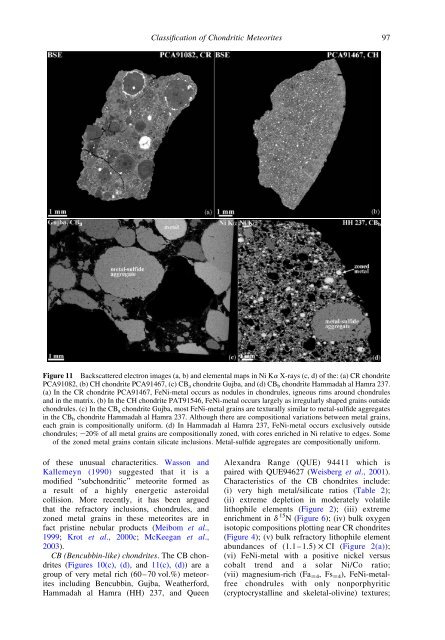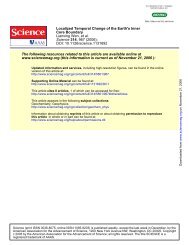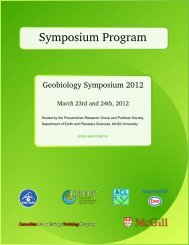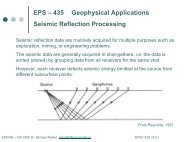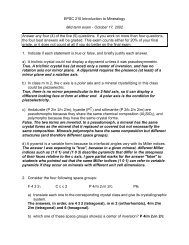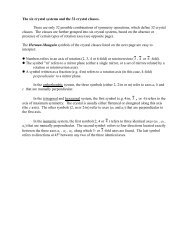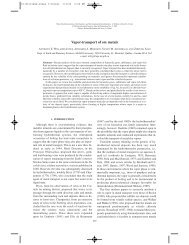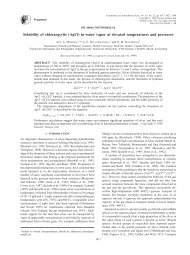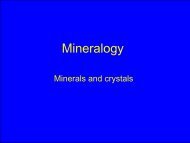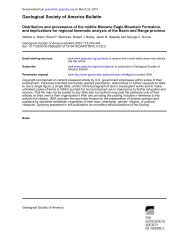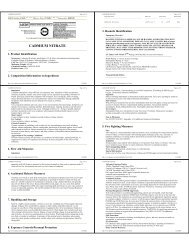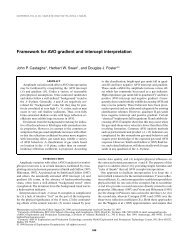05 Classification of.. - Department of Earth and Planetary Sciences
05 Classification of.. - Department of Earth and Planetary Sciences
05 Classification of.. - Department of Earth and Planetary Sciences
Create successful ePaper yourself
Turn your PDF publications into a flip-book with our unique Google optimized e-Paper software.
<strong>Classification</strong> <strong>of</strong> Chondritic Meteorites 97<br />
Figure 11 Backscattered electron images (a, b) <strong>and</strong> elemental maps in Ni Ka X-rays (c, d) <strong>of</strong> the: (a) CR chondrite<br />
PCA91082, (b) CH chondrite PCA91467, (c) CB a chondrite Gujba, <strong>and</strong> (d) CB b chondrite Hammadah al Hamra 237.<br />
(a) In the CR chondrite PCA91467, FeNi-metal occurs as nodules in chondrules, igneous rims around chondrules<br />
<strong>and</strong> in the matrix. (b) In the CH chondrite PAT91546, FeNi-metal occurs largely as irregularly shaped grains outside<br />
chondrules. (c) In the CB a chondrite Gujba, most FeNi-metal grains are texturally similar to metal-sulfide aggregates<br />
in the CB b chondrite Hammadah al Hamra 237. Although there are compositional variations between metal grains,<br />
each grain is compositionally uniform. (d) In Hammadah al Hamra 237, FeNi-metal occurs exclusively outside<br />
chondrules; ,20% <strong>of</strong> all metal grains are compositionally zoned, with cores enriched in Ni relative to edges. Some<br />
<strong>of</strong> the zoned metal grains contain silicate inclusions. Metal-sulfide aggregates are compositionally uniform.<br />
<strong>of</strong> these unusual characteritics. Wasson <strong>and</strong><br />
Kallemeyn (1990) suggested that it is a<br />
modified “subchondritic” meteorite formed as<br />
a result <strong>of</strong> a highly energetic asteroidal<br />
collision. More recently, it has been argued<br />
that the refractory inclusions, chondrules, <strong>and</strong><br />
zoned metal grains in these meteorites are in<br />
fact pristine nebular products (Meibom et al.,<br />
1999; Krot et al., 2000c; McKeegan et al.,<br />
2003).<br />
CB (Bencubbin-like) chondrites. The CB chondrites<br />
(Figures 10(c), (d), <strong>and</strong> 11(c), (d)) are a<br />
group <strong>of</strong> very metal rich (60–70 vol.%) meteorites<br />
including Bencubbin, Gujba, Weatherford,<br />
Hammadah al Hamra (HH) 237, <strong>and</strong> Queen<br />
Alex<strong>and</strong>ra Range (QUE) 94411 which is<br />
paired with QUE94627 (Weisberg et al., 2001).<br />
Characteristics <strong>of</strong> the CB chondrites include:<br />
(i) very high metal/silicate ratios (Table 2);<br />
(ii) extreme depletion in moderately volatile<br />
lithophile elements (Figure 2); (iii) extreme<br />
enrichment in d 15 N(Figure 6); (iv) bulk oxygen<br />
isotopic compositions plotting near CR chondrites<br />
(Figure 4); (v) bulk refractory lithophile element<br />
abundances <strong>of</strong> (1.1–1.5) £ CI (Figure 2(a));<br />
(vi) FeNi-metal with a positive nickel versus<br />
cobalt trend <strong>and</strong> a solar Ni/Co ratio;<br />
(vii) magnesium-rich (Fa #4 ,Fs #4 ), FeNi-metalfree<br />
chondrules with only nonporphyritic<br />
(cryptocrystalline <strong>and</strong> skeletal-olivine) textures;


